Contact Rate in Customer Service Explained with Actionable Tips
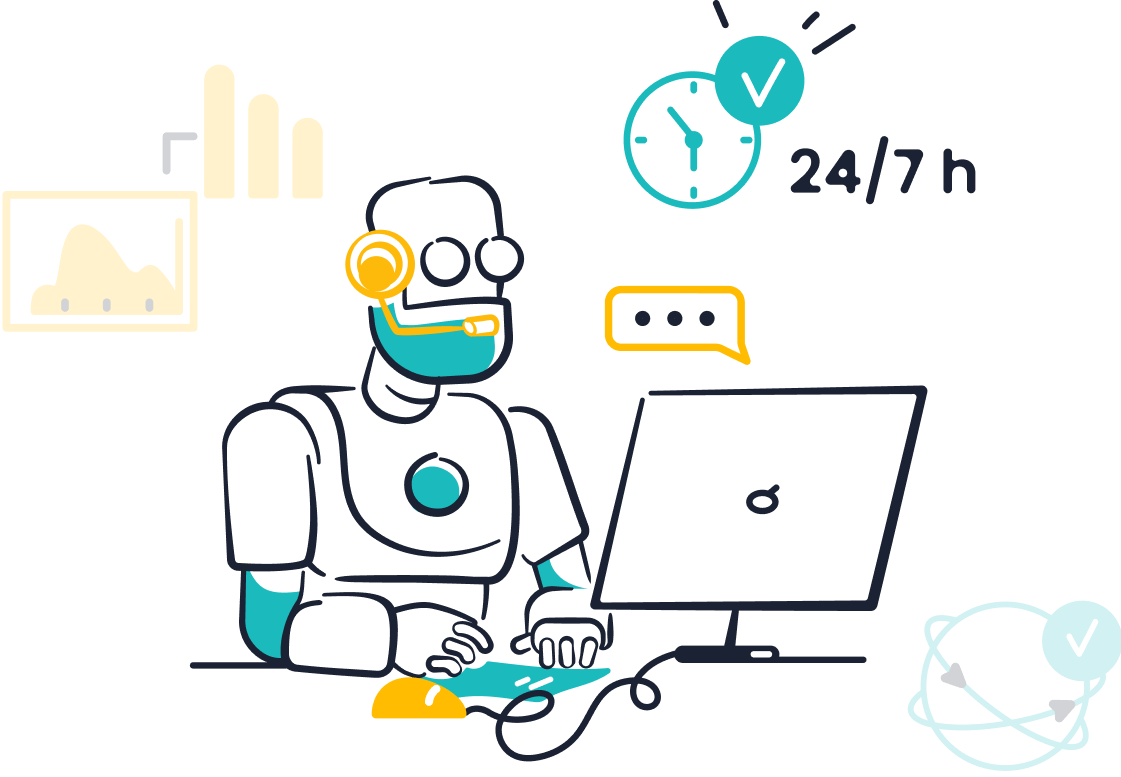
You might wonder what contact rate in customer service means. It shows how often customers reach out for help, like when they call, chat, or email your team. High contact rates can signal rising expectations—54% of customers now expect better service than last year. When you manage and lower your contact rate in customer service, you give your customers faster answers and boost efficiency. Sobot and Sobot AI help companies meet these needs, making customer experience smoother and easier for everyone.
Contact Rate in Customer Service
Definition
When you hear about contact rate in customer service, think of it as a way to measure how often your customers reach out for help. This metric shows the percentage of active customers who contact your support team within a set time, like a week or a month. You calculate it by dividing the number of customers who make inquiries by your total customer count, then multiplying by 100.
- If you see a high contact rate in customer service, it usually means your customers have lots of questions or run into problems.
- Sometimes, it points to confusing instructions or unclear processes that make customers reach out more often.
- A high contact rate can overwhelm your agents and slow down response times.
Why It Matters
Contact rate in customer service matters because it tells you how well you meet your customers’ needs. If your customers keep making inquiries, they might not find answers easily. Research shows that customer support interactions are four times more likely to cause disloyalty than loyalty. When you lower your contact rate, you help your team work faster and give customers a smoother experience.
Industry studies show that improving customer experience metrics like Net Promoter Score (NPS) and Customer Satisfaction Score (CSAT) leads to higher revenue and better business results. Metrics such as First Contact Resolution (FCR) and response time also help you understand what your customers need and how to improve your service.
Common Scenarios
You can see the impact of contact rate in customer service in many real-world situations. Here are some examples:
| Company | Contact Rate / Response Rate | Operational Impact / Outcome |
|---|---|---|
| ICON | 100% survey response rate | Customer-centric action plans led to deeper loyalty and a 98.8% customer retention rate. |
| HeidelbergCement | Over 70% survey response rate | Personalized follow-ups strengthened customer relationships and improved business outcomes. |
You might notice more inquiries when you launch a new product or update your website. If your FAQ or self-service options are not clear, customers will reach out more. Companies like Sobot help you manage these situations by offering tools like chatbots and unified support channels. These solutions let customers find answers quickly and reduce the number of inquiries your team handles.
Measuring Contact Rate

Formula
You can measure contact rate in customer service with a simple formula. Here’s how it works:
Contact Rate (%) = (Number of Customers Who Contacted Support ÷ Total Number of Customers) × 100
Let’s say you have 1,000 customers, and 150 of them reached out for help this month. Plug those numbers into the formula:
Contact Rate = (150 ÷ 1,000) × 100 = 15%
This means 15% of your customers needed support during that time. Keeping track of this number helps you spot trends and see if your service is easy to use.
Example
Imagine you run an online store. Last month, you had 2,000 customers. Out of those, 300 people sent emails or called your support team. Using the formula above, your contact rate would be:
Contact Rate = (300 ÷ 2,000) × 100 = 15%
You can compare this number month by month. If your contact rate goes up, it might mean customers are having trouble finding answers on their own. If it drops, your self-service tools or chatbot might be working well.
Here’s a quick look at other important metrics you can track alongside contact rate:
| Metric Name | Description | Benchmark Example |
|---|---|---|
| Average Call Abandonment Rate | Calls disconnected before reaching an agent. | 6.44% (global average) |
| Average Time in Queue | How long customers wait before speaking to someone. | 22% say wait times are too long |
| Service Level | Calls answered within a target time (like 80% in 30 seconds). | 80/30 is a common goal |
| First Call Resolution (FCR) | Issues solved on the first try. | Nearly 90% value fast resolution |
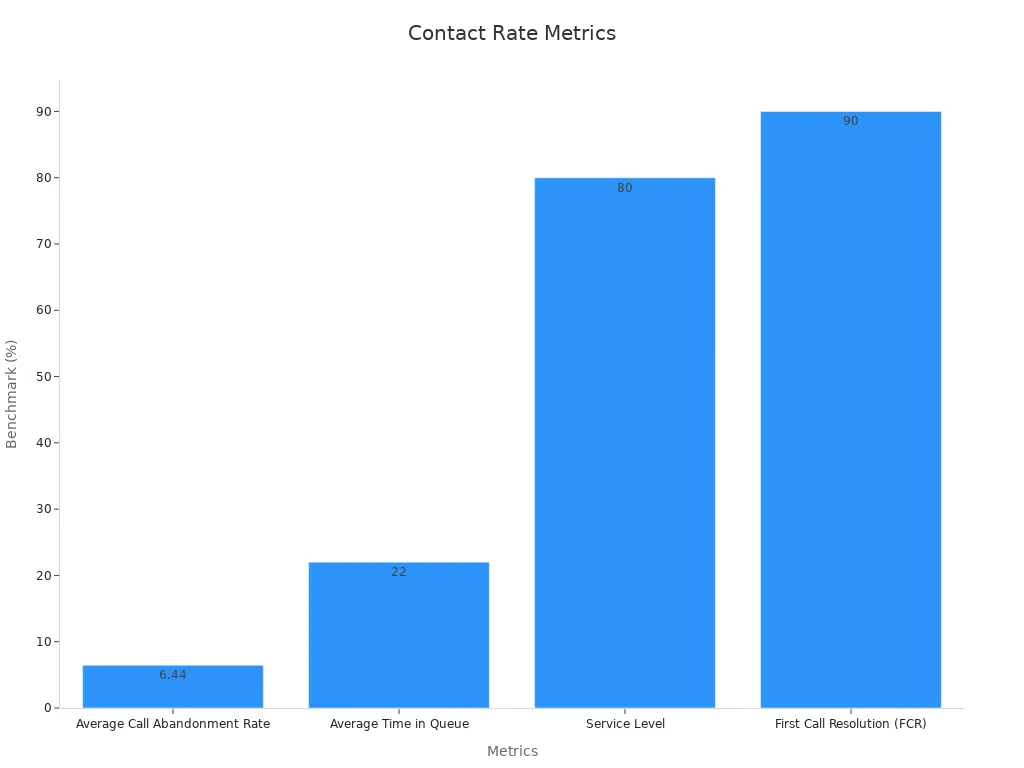
Analysis
Once you know your contact rate, you can dig deeper to find out what’s really going on. Here are some ways you can analyze your data:
- Descriptive analysis helps you see the average and trends over time.
- Diagnostic analysis lets you spot patterns or reasons for spikes.
- Predictive analysis uses past data to guess what might happen next.
- Prescriptive analysis suggests steps you can take to improve contact rate.
- Exploratory data analysis helps you find surprises or hidden issues.
Sobot’s analytics tools make this process much easier. You get real-time dashboards and reports that show your contact rate, first contact resolution, and more. With these insights, you can quickly spot problems and take action to improve contact rate. You can also see how changes—like adding a chatbot or updating your knowledge base—affect your numbers. This way, you always know what’s working best for your customers.
Impact on Customers
Customer Experience
You want your customers to feel heard and valued at every step of their journey. When you keep your contact rate low, you help customers find answers quickly. This makes their customer experience smoother and more enjoyable. Imagine a customer who finds what they need in your knowledge base or gets instant help from a chatbot. They leave happy and ready to return.
A great customer experience starts with understanding needs. You can use empathy and emotional intelligence to connect with customers. When you show empathy, you build trust. Sobot’s omnichannel platform lets you track every interaction, so you never miss a detail in the customer journey. This helps you spot pain points and improve customer satisfaction.
Tip: Companies that focus on customer experience see higher customer satisfaction scores and better customer retention. According to Forrester, brands with superior customer experience grow revenues faster than their competitors.
Satisfaction and Loyalty
Customer satisfaction is more than just a number. It shapes how customers feel about your brand and if they stay loyal. High customer satisfaction scores often lead to better customer retention. When you meet customer needs and resolve issues fast, you boost customer loyalty.
Empathy and emotional intelligence play a big role here. If your team listens and responds with care, customers remember. Sobot’s AI-powered chatbot helps you deliver quick, accurate answers, which increases customer satisfaction and supports customer retention. You can see this in action with OPPO, who improved their customer satisfaction and saw a 57% increase in customer retention after using Sobot.
A positive customer journey leads to more repeat business. When you focus on every interaction, you build strong relationships and improve customer loyalty. Happy customers share their experiences, helping your brand grow.
Omnichannel Support Strategies
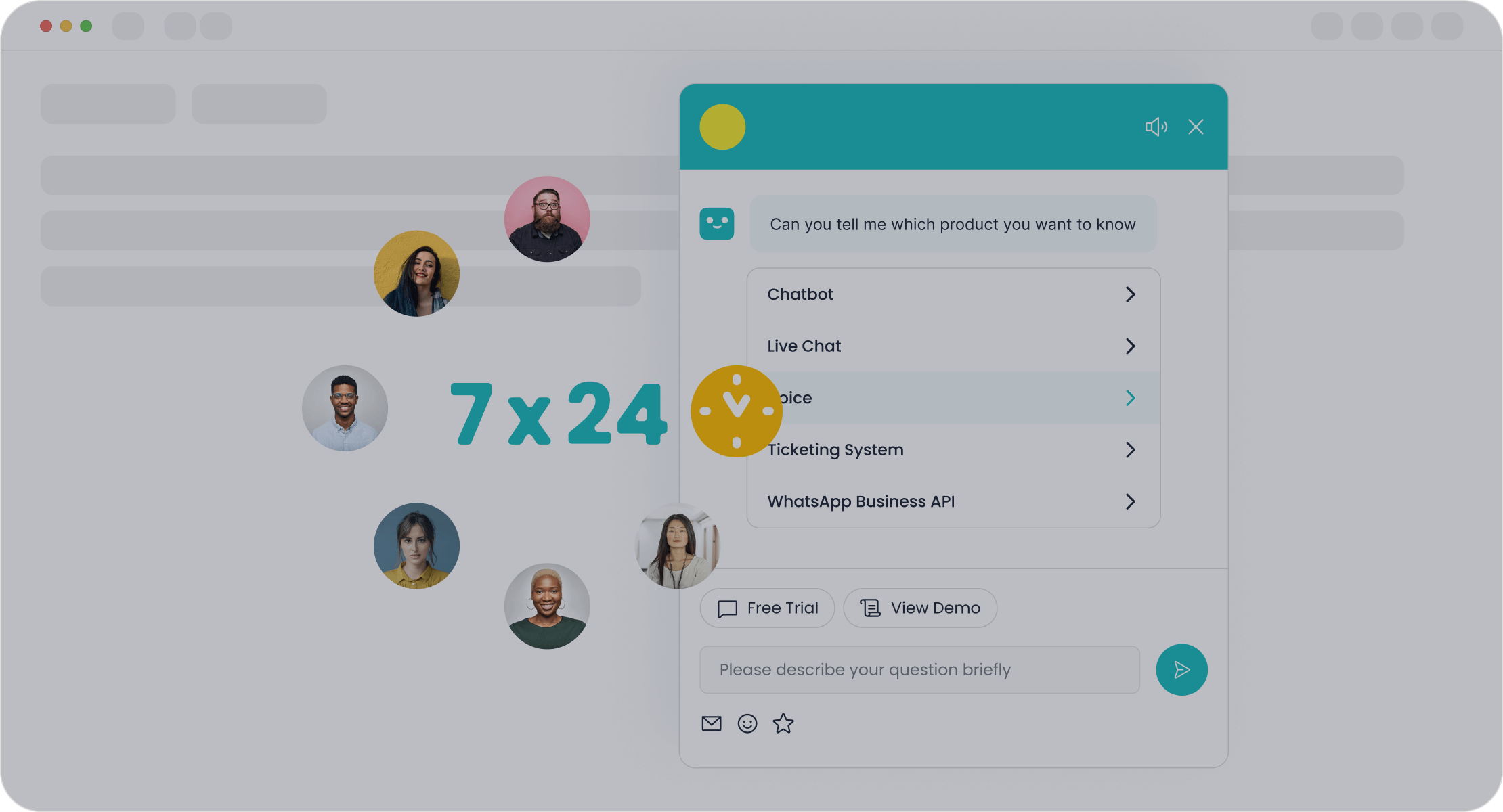
Unified Channels
When you use unified channels, you bring all your customer conversations into one place. This means your team can see emails, chats, calls, and social messages together. You do not have to switch between different screens or search for past conversations. Everything is right there, making it easy to help customers fast.
Unified communication systems help your team answer questions with the right information. For example, in retail, agents can check order status, product details, and delivery updates in real time. This helps you solve problems on the first try and keeps customers happy. When you give quick, personal answers, customers do not need to contact you again for the same issue. This lowers your contact rate and saves time for everyone.
You also get better teamwork. Staff can share updates and work together, so customers get the right answers. With unified channels, you can use smart tools like live chat and FAQs to answer simple questions instantly. This lets your agents focus on more complex problems.
Companies using unified omnichannel systems see fewer repeat contacts and faster resolutions. Customers feel heard, and your team works more efficiently.
Sobot Omnichannel Solution
Sobot’s omnichannel solution gives you everything you need to manage customer conversations across all channels. You get a single workspace where agents see every message, call, and chat in one view. This makes it easy to track customer history and give personal support.
Here’s why Sobot’s omnichannel support stands out:
- You can connect with customers on their favorite apps, like WhatsApp, SMS, and social media.
- Agents have access to all customer data, so they do not waste time searching for information.
- Sobot’s tools help you automate replies to common questions, freeing up your team for bigger issues.
- Real-time analytics show you how your team is doing and where you can improve.
With Sobot, you reduce your contact rate because customers get answers quickly and do not need to reach out again. You also boost customer retention and satisfaction. Studies show that companies with strong omnichannel support keep up to 89% of their customers and see a 91% increase in retention year-over-year. Sobot’s solution helps you deliver the fast, personal service your customers expect.
Self-Service and Chatbot Solutions
You want your customers to get answers fast. Self-service and chatbot solutions make that possible. These options help your team handle more requests, cut down on repeat inquiries, and boost efficiency. Let’s see how you can use these tools to transform your customer service.
Sobot Chatbot
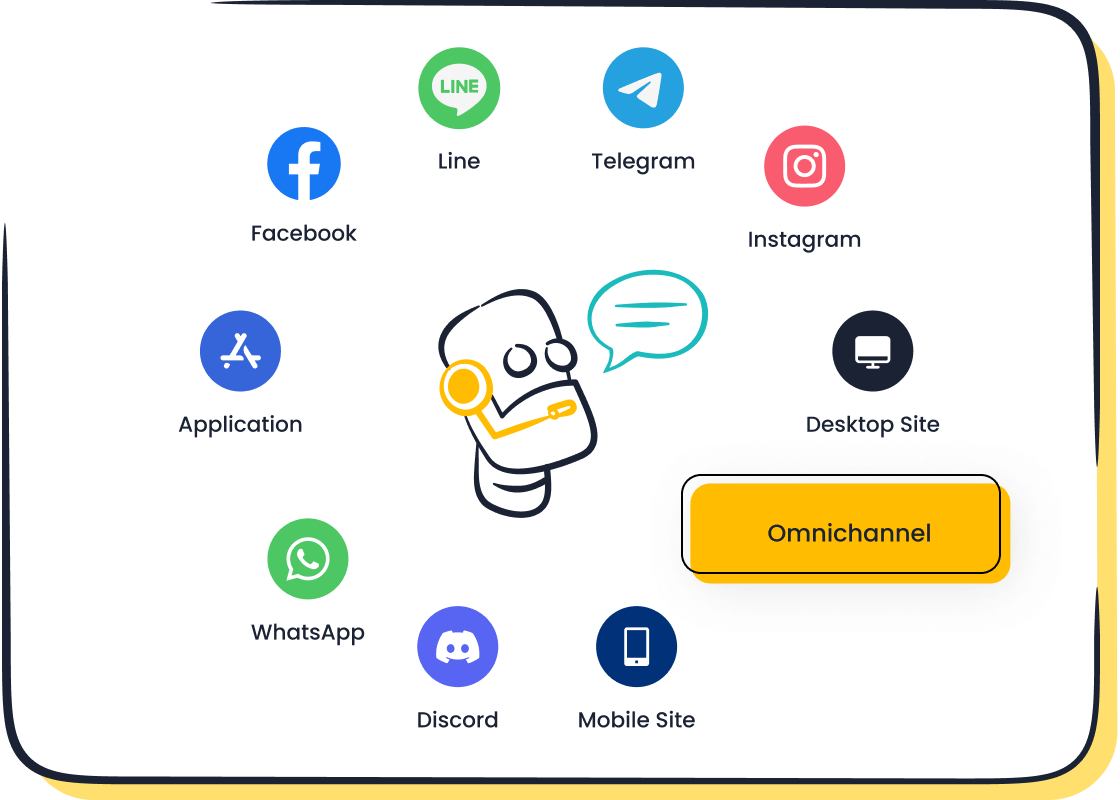
Sobot’s AI-powered chatbot gives your customers instant help, day or night. You can set it up without any coding. The chatbot understands multiple languages and works across all your channels, like WhatsApp, SMS, and your website. When customers ask simple questions, the chatbot replies in as little as two seconds. That means your team can focus on more complex issues.
Here’s what happens when you use Sobot Chatbot:
- You answer common questions automatically, so your agents have more time for tough problems.
- You see a 25% drop in first response times and a 40% jump in issue resolution rates.
- Customers feel satisfied—95% say they like the speed and accuracy.
| Metric Description | Value |
|---|---|
| AI chatbot response time | As fast as 2 sec |
| First response time | Under 1 minute |
| Reduction in first response times | 25% decrease |
| Increase in issue resolution rates | 40% increase |
| Customer satisfaction with AI speed/accuracy | 95% satisfied |
| Issues resolved on first contact | 90% |
| Customer recommendation rate for support | 90% |
Tip: Sobot Chatbot can handle thousands of conversations at once. You never have to worry about long wait times during busy periods.
OPPO, a global smart device leader, used Sobot’s chatbot and saw amazing results. During shopping festivals, OPPO faced a flood of inquiries. With Sobot, they reached an 83% chatbot resolution rate and a 94% positive feedback rate. Their repurchase rate jumped by 57%. You can read more about OPPO’s story here.
Knowledge Base
A strong knowledge base lets your customers find answers on their own. You can fill it with FAQs, guides, and step-by-step instructions. Sobot makes it easy to build and update your knowledge base. You can upload articles, PDFs, and even Excel files. The chatbot uses this information to give instant replies.
When you have a good knowledge base, you see fewer repeat contacts. Customers don’t have to explain their problems again and again. Agents also get quick access to the right data, so they can give personal and accurate answers.
| Statistic Description | Percentage |
|---|---|
| Customers who must repeat or re-explain information | 56% |
| Agents reporting lack of consumer data causes negative experiences | 58% |
| Customer service reps describing their service as very personalized | 47% |
Note: A well-organized knowledge base can cut support tickets by 50% and help your team work with more efficiency.
24/7 Support
Customers want help any time, not just during business hours. Sobot’s chatbot and self-service tools work around the clock. You can offer support even when your team is offline. This means customers get answers right away, no matter where they are or what time it is.
Most people prefer to solve problems themselves. In fact, 67% would rather use self-service than talk to a representative. Chatbots handle simple questions for 74% of customers. Self-service portals resolve issues three times faster than traditional channels. You save time and your customers feel valued.
| Statistic / Insight | Supporting Data | Source |
|---|---|---|
| Customer preference for self-service | 67% prefer self-service over speaking to a representative | Zendesk |
| Preference for chatbots for simple queries | 74% would choose chatbots for simple questions | Tidio |
| Cost reduction from chatbots | Up to 30% reduction in customer service costs | Chatbots Magazine |
| Increase in customer satisfaction (CSAT) | Average 45% increase after adopting self-service | Service Target |
| Speed of issue resolution | Self-service portals resolve issues 3x faster than traditional channels | ASAR Digital |
| Customer tendency to self-serve | 81% attempt to solve issues themselves before contacting live support | Harvard Business Review |
| Reduction in support tickets | 50% drop after deploying knowledge base and chatbots | Messente Communication CEO |
| Decrease in call center traffic | 40% decrease using IBM Watson Assistant | IBM |
| Time savings in response | 2 minutes cut in first-response time, 1,058 team hours saved quarterly | Qonto Onboarding Head |
| Importance of valuing customer time | 73% say valuing time is key to good service | Forrester |
| Preference for website self-service | 73% prefer website portals for issue resolution | Dimension Data |
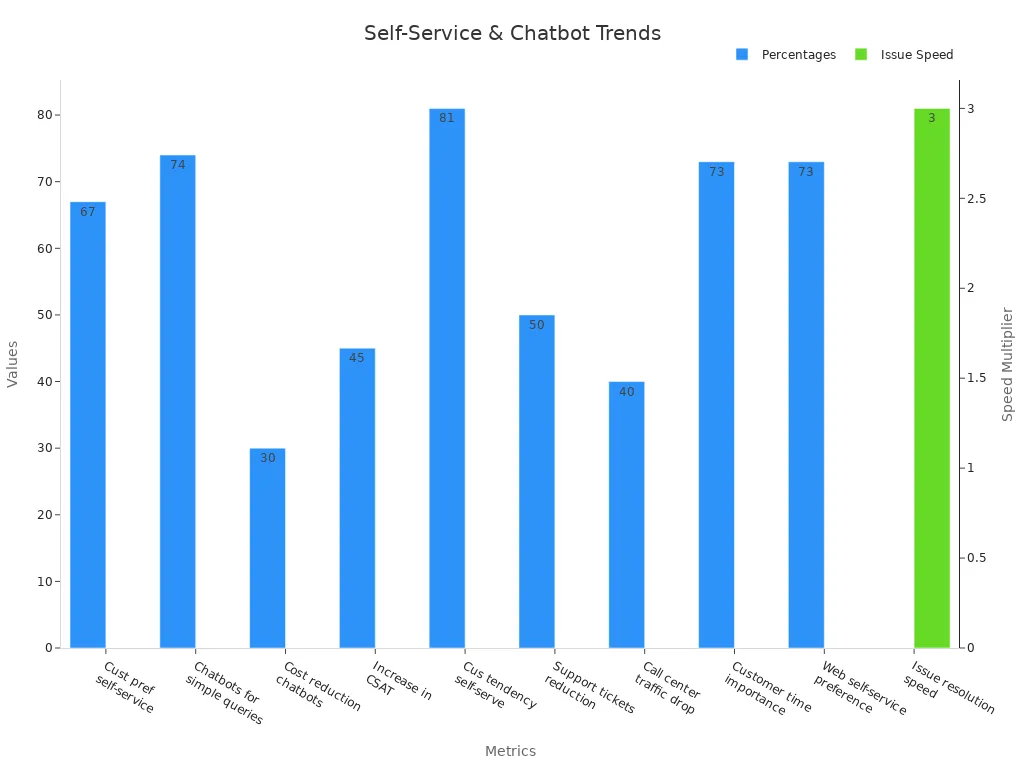
You can see that self-service and chatbots are not just trends. They are powerful tools that drive efficiency, cut costs, and make your customers happier. Sobot’s automation and easy-to-use tools help you deflect contacts, improve response times, and keep your support running smoothly 24/7.
Call Center Customer Service Optimization
Optimizing your call center customer service can make a huge difference in how you handle interactions and keep customers happy. When you focus on training, smart routing, and solving problems on the first try, you lower costs and boost satisfaction. Let’s break down how you can improve customer service and make every interaction count.
Agent Training
You want your team to feel confident and ready for any question. Good training helps agents solve problems faster and reduces repeated contacts. When you invest in training, you see better First Contact Resolution (FCR) rates and fewer escalations. Here’s what strong agent training brings:
- Agents resolve more issues on the first call, which means fewer repeat interactions.
- Escalation rates drop because agents know how to handle tough questions.
- Customer Effort Score (CES) improves, making it easier for customers to get help.
- Real-time feedback and coaching help agents grow and adapt quickly.
Sobot’s platform supports real-time dashboards and AI-powered coaching. This lets you spot skill gaps and tailor training, so your team keeps getting better at every step of the customer service journey.
Skill-Based Routing
Skill-based routing sends each call to the agent best suited for the job. This approach speeds up resolutions and makes interactions smoother for everyone. Here’s why it works:
- Calls go straight to agents with the right skills, so customers get answers faster.
- Agents focus on what they do best, which keeps them motivated and engaged.
- You see fewer transfers and shorter handle times, which lowers operational costs.
- Customers feel valued because their issues get solved by the right person.
With Sobot, you can set up smart workflows that match customer needs to agent strengths. This not only improves customer service interactions but also helps your team work more efficiently.
First Contact Resolution
First Contact Resolution (FCR) is all about solving problems the first time a customer reaches out. High FCR rates mean fewer repeat calls and happier customers. Check out these industry benchmarks:
| Industry | Average First Contact Resolution (FCR) Rate (%) |
|---|---|
| Retail | 77–88 |
| Insurance | 75–84 |
| Tech support | 65–79 |
| Telecommunications | 61–73 |
When you improve FCR, you control your contact rate and boost loyalty. For example, raising FCR from 70% to 80% in a busy call center can mean 100 fewer repeat contacts for every 1,000 calls. Sobot’s analytics and omnichannel tools help you track FCR and spot ways to improve customer service, making every interaction count.
Tip: Focus on FCR to reduce your contact rate and keep your customers coming back. Learn more about FCR benchmarks.
Feedback and Continuous Improvement
Feedback Loops
You want your customers to feel heard at every step of their journey. Feedback loops help you do just that. When you collect feedback from surveys, support tickets, social media, and reviews, you get a full picture of what customers think and feel. Centralizing this feedback in one place helps your team spot trends and fix problems faster. AI-powered tools can even sort through huge amounts of feedback, picking out common themes and urgent issues. Companies that close the feedback loop—by acting on feedback and letting customers know about changes—see a 20% drop in repeated contacts and higher satisfaction. This approach builds trust and shows customers you value their input.
- Collect feedback from many sources
- Use AI to find patterns and urgent needs
- Share results with your team to drive action
Data Analytics
Data analytics turns feedback into real action. You can track key performance indicators (KPIs) like customer satisfaction scores, first response time, and ticket volume. These KPIs show where your service shines and where you need to improve. With the right tools, you can spot bottlenecks, measure how fast your team solves problems, and see which issues come up most often. Sobot’s reporting and optimization tools make this easy. You get dashboards that show trends, highlight slowdowns, and help you make smart decisions. Predictive analytics can even warn you about future challenges, so you stay ahead.
| KPI Name | What It Shows |
|---|---|
| Customer Satisfaction | How happy customers are |
| First Response Time | How quickly you reply |
| Ticket Volume | How many issues customers report |
Customer Insights
When you dig into customer insights, you learn what your customers really want. Analyzing KPIs and feedback helps you understand their needs and expectations. You can see which products or services get the most questions, which agents solve problems fastest, and where customers get stuck. This lets you adjust your training, update your knowledge base, or automate common answers. Sobot’s analytics tools help you turn these insights into action, making your service better every day. By focusing on customer insights, you boost satisfaction, loyalty, and efficiency.
Tip: Tracking the right KPIs and acting on customer insights leads to happier customers and fewer repeat contacts.
You can boost customer experience and improve customer service outcomes by managing your contact rate. Focus on key metrics like Net Promoter Score, Customer Satisfaction Score, and First Contact Resolution Rate. These help you spot trends and keep customer satisfaction high. Sobot’s omnichannel and chatbot tools make it easy to deliver fast answers and support around the clock. When you balance quick help with personal care, you see better retention and a stronger customer experience.
- Track these KPIs for success:
- Customer Satisfaction Score (CSAT)
- Net Promoter Score (NPS)
- First Contact Resolution Rate
- Average Response Time
- Call Abandonment Rate
FAQ
What is contact rate in customer service?
Contact rate in customer service shows how many customers reach out for help compared to your total customer base. For example, if 200 out of 2,000 customers contact you, your contact rate is 10%. This metric helps you spot trends and improve support.
Why should you care about contact rate in customer service?
A high contact rate in customer service means customers struggle to find answers on their own. This can slow down your team and lower satisfaction. Lowering your contact rate helps you boost efficiency and keep customers happy. Sobot’s chatbot and knowledge base can help reduce unnecessary contacts.
How can Sobot help you lower your contact rate in customer service?
Sobot offers an AI-powered chatbot, a unified workspace, and a smart knowledge base. These tools let customers find answers fast, which lowers your contact rate in customer service. OPPO used Sobot and saw an 83% chatbot resolution rate and a 57% increase in repurchase rate.
What is a good contact rate in customer service?
A good contact rate in customer service depends on your industry. Many companies aim for a rate below 15%. If your contact rate is higher, you may need to improve self-service options or update your FAQs. Learn more about industry benchmarks here.
How do you track changes in contact rate in customer service?
You can track contact rate in customer service using analytics tools like Sobot’s real-time dashboard. These tools show you trends, spikes, and drops. When you add new features or update your support, you can see the impact right away and make smart decisions.
See Also
Effective Strategies To Improve Customer Satisfaction In Live Chat
Proven Best Practices For Managing Call Center Quality
How To Successfully Manage Live Chat Agents Daily
